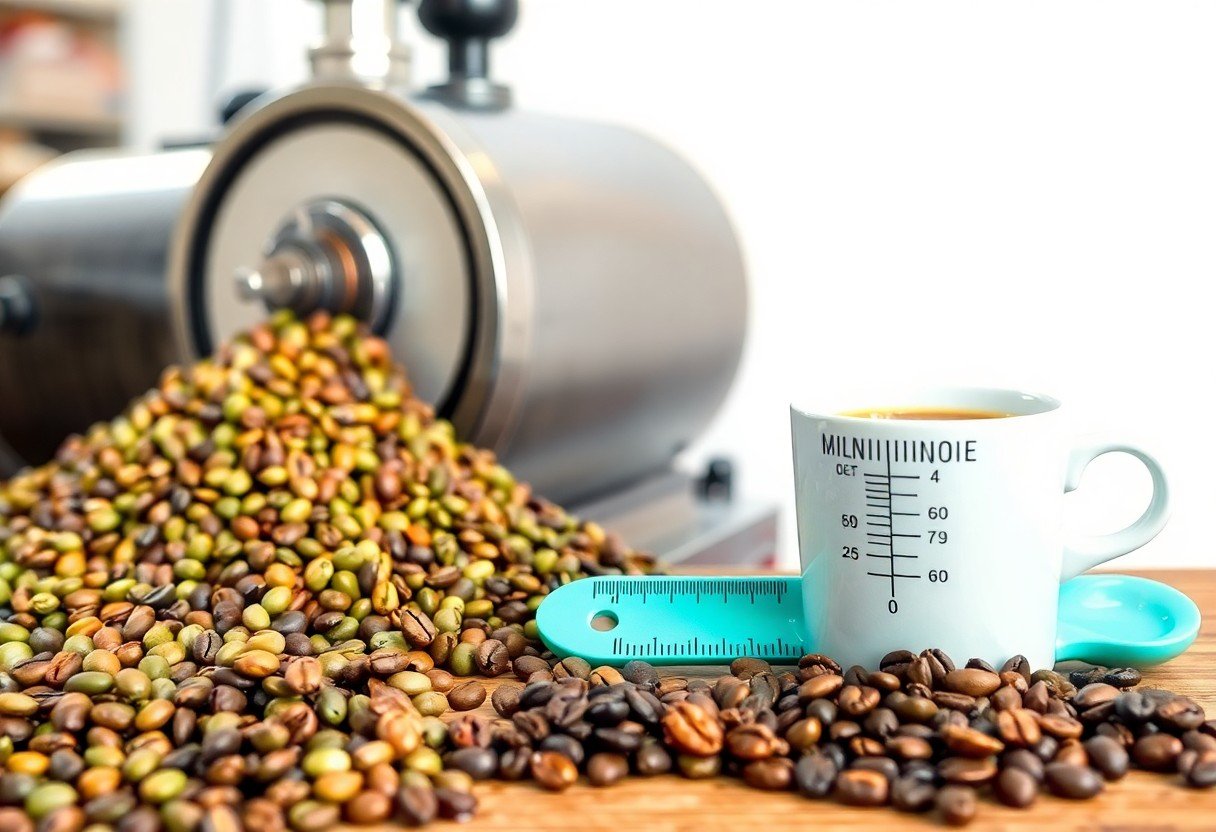Many coffee lovers underestimate the impact of fresh roasted coffee on their daily cup. While supermarket selections often emphasize convenience, they can lack the rich flavors and aromas that come from freshly roasted beans. By exploring fresh coffee, you can elevate your brewing experience and truly savor the nuances that high-quality beans can offer. In this blog post, you’ll discover how fresh roasted coffee can transform your mornings, enhance your palate, and lead you to a deeper appreciation of this beloved beverage.
The Sensory Revolution: Why Freshness Matters
Freshly roasted coffee introduces a sensory explosion that fundamentally changes your coffee experience. Freshness influences not only the taste but also the aroma, mouthfeel, and overall satisfaction of each cup. When coffee beans are roasted, volatile compounds and oils are released, creating rich flavors that fade over time. A freshly roasted brew bridges the gap between the bean and the cup, allowing each sip to resonate with vibrancy and character that aged coffee simply cannot replicate.
Taste and Aroma: The Impact of Fresh Roasting
The first hint of freshly roasted coffee greets you with an aromatic embrace that lingers long after the first sip. As the oils and compounds remain intact, each cup delivers a symphony of flavors, from chocolatey notes to fruity undertones. Fresh roasting elevates the experience, ensuring that the harmonious balance of bitterness, acidity, and sweetness is pronounced, invigorating your senses like never before.
Analyzing the Flavor Profile: What Sets Fresh From Aged Apart
Distinct differences emerge when comparing fresh and aged coffee, with freshness enhancing complexity while age often dulls flavors. Freshly roasted beans retain their vibrant profiles, allowing fruity, floral, nutty, and chocolate nuances to flourish and evolve in your cup. In contrast, aged beans can develop flat, muted flavors, losing the crucial characteristics that make coffee intriguing and delightful.
Delving deeper into the flavor profile reveals that freshly roasted beans exhibit brighter acidity and fuller body, inviting a dynamic range of tastes. For example, a freshly roasted Ethiopian Yirgacheffe might unveil layers of citrus and jasmine, whereas an aged equivalent could present uninviting earthy notes devoid of the lively essence. To fully appreciate the nuances of your favorite beans, savoring them freshly roasted not only enhances your experience but deepens your understanding of coffee’s vast flavor landscape. The dedication to quality in freshness ultimately translates into a superior tasting experience that leaves an indelible mark on your palate.

The Journey from Bean to Brew: Understanding the Process
Each cup of coffee you savor starts its life as a humble cherry on a coffee tree. After being handpicked at the peak of ripeness, the cherries undergo a meticulous process involving sorting, pulping, fermenting, and drying to reveal the green coffee beans. These beans then travel to roasters, where they’re transformed in a dance of heat, developing the rich flavors and aromas that define your favorite brews. Understanding this journey enhances your appreciation, allowing you to connect the dots from the farm to your mug.
The Importance of Origin: How Geography Influences Flavor
Your coffee’s flavor profile is deeply influenced by its geographical origin. Factors like altitude, climate, and soil composition contribute significantly to the nuances of taste. For example, Ethiopian coffees are often celebrated for their fruity and floral notes, while Colombian varieties tend to offer a balanced sweetness with hints of chocolate. By exploring coffees from distinct regions, you can discover how each locale shapes the beans, adding a unique character to every brew.
Roast Levels and Their Effects on Coffee Characteristics
The roast level directly impacts your coffee’s taste, aroma, and body. Light roasts preserve the coffee’s original flavors, showcasing the distinct notes of its origin, while medium roasts present a balanced profile, combining sweetness with slight acidity. Dark roasts emphasize boldness, producing a heavier body and a pronounced smoky flavor. Each roast level caters to different palates, allowing you to experiment and find your preferred taste sensation.
Light roasts typically contain more of the coffee’s inherent acidity, making them vibrant and complex, often highlighting fruity or floral qualities. As the beans progress to medium roasts, the flavors experience a transformation, blending the brightness of acidity with sugars, resulting in sweetness and a fuller body. Conversely, dark roasts, while rich and bold, can obscure origin flavors, focusing instead on chocolatey, bitter notes. Choosing the right roast not only affects taste but also your overall coffee experience, adding layers of depth to each sip.
Breaking Down the Economics: Fresh Roasted vs. Supermarket Brands
Your coffee choices can significantly impact your budget and overall experience. Fresh roasted coffee typically costs a bit more upfront than supermarket brands, but the difference in quality often justifies that price tag. Supermarket coffee often sacrifices flavor and freshness to achieve lower costs, which can lead to a lackluster cup in comparison. When you factor in the experience and enjoyment derived from a fresh brew, the economics can skew favorably toward specialty roasters.
Price vs. Quality: What You’re Really Paying For
The Cost of Convenience: Is Pre-Packaged Coffee Worth It?
Crafting the Perfect Cup: Practical Tips for Coffee Lovers
Elevating your coffee game hinges on understanding the nuances tied to fresh roasted beans. Begin by considering these practical tips for a consistently stellar brew:
- Choose whole beans over pre-ground.
- Experiment with grind size based on your brewing method.
- Use clean, filtered water to maintain flavor integrity.
- Measure your coffee and water for optimal strength.
- Invest in a good grinder and brewer.
Thou art now equipped with necessary knowledge to take your coffee experience to new heights.
Brewing Methods: How to Optimize Fresh Roasted Beans
Selecting the right brewing method can significantly influence the flavor profile of your cup. For fresh roasted beans, consider options like pour-over for a clean taste or French press to bring out richer oils. The recommended water temperature is between 195°F to 205°F, allowing for optimal extraction without compromising flavors. Aiming for a coffee-to-water ratio of 1:16 enhances the balance in your brew, showcasing the unique characteristics of each fresh roast.
Storage Essentials: Keeping Your Coffee Fresh Longer
To maintain the fresh flavor of your roasted beans, proper storage is key. Always store your coffee in an airtight container, ideally one that minimizes exposure to light, heat, and moisture, such as a dark glass jar. A cool, dry pantry is preferable, as the fridge can introduce unwanted moisture. Consider purchasing only what you can consume in a couple of weeks to ensure your beans remain at peak freshness and their delightful flavor is preserved.
Extending the life of your fresh roasted coffee necessitates vigilance. For instance, vacuum-sealed bags can effectively stave off oxidation, while those designed with one-way valves can release gases without sacrificing flavor. Additionally, purchasing beans in smaller quantities allows you to focus on freshness and variety, making each cup an exploration of flavor. By adhering to these storage techniques, you ensure that every sip remains as vibrant and aromatic as your first brew.
The Community Connection: Supporting Local Roasters
Choosing fresh roasted coffee often leads you to explore local roasters, fostering a deep connection with community producers. When you invest in local artisan coffee, you’re supporting your neighborhood’s economy and helping maintain the unique character that independent shops bring to the culinary landscape. Local roasters typically prioritize quality over quantity, providing you with beans sourced from sustainable farms while maintaining genuine relationships with the farmers. This connection not only results in superior flavor profiles but also emphasizes ethical practices throughout the production process.
Building Relationships: The Benefits of Buying Local
By supporting local roasters, you’re not just purchasing coffee; you’re building relationships with the people who craft your favorite brews. These connections offer insight into the sourcing, roasting, and brewing methods, enhancing your appreciation for the complex world of coffee. Engaging directly with roasters allows you to customize your coffee experience, learning about different bean origins and blends tailored to your palate. This personal interaction enriches the coffee journey, transforming a simple commodity into a story woven with community support.
New Trends: The Rise of Micro-Roasteries and Their Impact
The micro-roastery movement has taken the coffee world by storm, drastically changing how you approach your morning cup. These small-scale roasters focus on quality, innovation, and customization, enabling you to discover a diverse range of flavors not typically found in supermarket brands. With an emphasis on sustainability and unique brewing techniques, micro-roasteries are redefining coffee culture. Many of them offer subscription services, bringing freshly roasted beans directly to your door, which ensures your coffee is always at its peak freshness while supporting artisanal practices.
Micro-roasteries emphasize smaller batches and personalized roasting profiles, showcasing single-origin beans that can vary significantly from traditional blends. This means you can experience distinct flavor notes that tell the story of the specific regions and cultivation methods. As consumers increasingly seek transparency in sourcing and sustainability, these roasters are filling a vital niche, pushing larger brands to reconsider their practices. The growth of micro-roasteries is not just a trend but a movement that enhances your coffee experience with authenticity and craft. Their impact extends far beyond the local level, encouraging a global shift towards more responsible coffee production while giving you a richer connection to your cup of joe.
To wrap up
With these considerations, fresh roasted coffee elevates your coffee experience far beyond the supermarket offerings. When you prioritize freshness, you unlock rich flavors and aromas that are often lost in mass production. You can explore unique coffee profiles and origins, allowing you to truly tailor your coffee to your taste preferences. By choosing freshly roasted beans, you not only support local roasters but also enjoy a more vibrant and satisfying cup that can redefine what you expect from your daily brew. Embrace this game-changer and transform your coffee rituals today.
FAQ
Q: What makes fresh roasted coffee different from supermarket coffee?
A: Fresh roasted coffee has a distinct advantage over supermarket varieties primarily due to its freshness and the roasting process. When coffee beans are roasted, they release oils and flavors that develop over time. Supermarket coffee often sits on shelves for long periods, resulting in a loss of flavor and aroma. Freshly roasted coffee, on the other hand, is typically consumed within days or weeks of roasting, preserving its vibrant taste and complex profiles. This means a cup of freshly roasted coffee can deliver a richer, more satisfying experience that showcases the unique characteristics of the beans used.
Q: How can I find fresh roasted coffee?
A: Finding fresh roasted coffee is easier than you might think. Look for local coffee roasters in your area; many offer direct sales to consumers and often have subscription services. Specialty coffee shops usually carry a selection of freshly roasted beans. Additionally, numerous online retailers focus on small-batch roasting and can ship directly to your door, ensuring you receive coffee at its peak freshness. Pay attention to roast dates on packaging, and aim to choose beans that have been roasted within the last two weeks for optimal flavor.
Q: Why should I prioritize fresh roasted coffee over pre-packaged options?
A: Prioritizing fresh roasted coffee enhances your overall coffee experience significantly. Freshly roasted beans not only taste better, but they also allow you to explore a variety of flavors that can be influenced by the origin of the beans, the roasting method, and even the brewing technique. Pre-packaged coffee often lacks the complexity that comes with freshness, limiting your tasting experience. By choosing fresh roasted options, you can enjoy vibrant flavors, unique aromas, and a more enjoyable cup that reflects the beans’ rich heritage.

